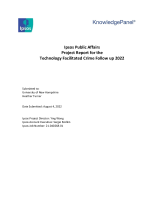Public opinion
Informal Control of Crime Through Neighborhood Networks
Helicopters and Their Use in Police and Pursuit: Attachments: Public Opinion Survey Breakdown of Attitudes by Demographic Data
Sources of Data That Identify and Measure the Impacts of Organized Crime
Research, Evaluation, and Analysis of Call Handling on Three-Digit Hotlines (REACH-3D)
Technology Facilitated Crime Follow-up 2022
Fractal analysis of fingerprints
National Symposium on Sentencing--The Judicial Response to Crime: Instructor's Guide for Classroom Video
Public Opinion and the Criminal Justice System: Building Support for Sex Offender Management Programs
Craniofacial Morphometric Analysis of Individuals with X-linked Hypohidrotic Ectodermal Dysplasia
Citizen Complaints as Threats to Police Legitimacy: The Role of Officers' Occupational Attitudes
On Immigration and Crime
End of an Era? Understanding the Contradictions of Criminal Justice Reform
State Responses to Mass Incarceration
Researchers have devoted considerable attention to mass incarceration, specifically its magnitude, costs, and collateral consequences. In the face of economic constraints, strategies to reduce correctional populations while maintaining public safety are becoming a fiscal necessity. This panel will present strategies that states have undertaken to reduce incarceration rates while balancing taxpayer costs with ensuring public safety.
See the YouTube Terms of Service and Google Privacy Policy
Less Prison, More Police, Less Crime: How Criminology Can Save the States from Bankruptcy
Professor Lawrence Sherman explains how policing can prevent far more crimes than prison per dollar spent. His analysis of the cost-effectiveness of prison compared to policing suggests that states can cut their total budgets for justice and reduce crime by reallocating their spending on crime: less prison, more police.
See the YouTube Terms of Service and Google Privacy Policy
From the Academy to Retirement: A Journey Through the Policing Lifecycle
Professor Rosenbaum and a panel of colleagues discuss a study to demonstrate the feasibility of creating a foundation from which to launch studies about multiple aspects of policing using standardized definitions and measurement tools. Their goal is to advance knowledge about policing and translate data into evidence-based best practices that improve training, supervision and accountability systems. The effort is expected to produce a better understanding of what motivates police officers and makes them healthier, happier and more effective.
See the YouTube Terms of Service and Google Privacy Policy
Changing the Behavior of Drug-Involved Offenders: Supervision That Works
A small number of those who commit crimes are heavily involved in drugs commit a large portion of the crime in this country. An evaluation of a "smart supervision" effort in Hawaii that uses swift and certain sanctioning showed that individuals committing crimes who are heavily involved in drug use can indeed change their behavior when the supervision is properly implemented.
See the YouTube Terms of Service and Google Privacy Policy



